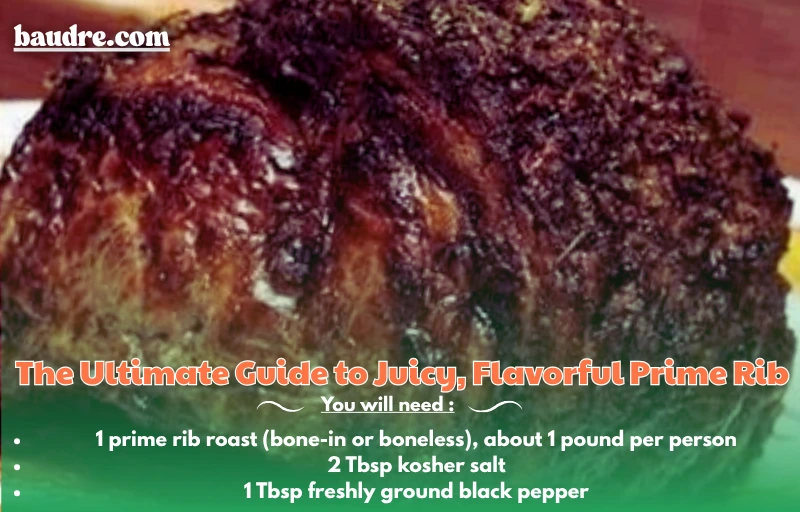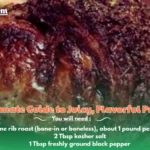Few dishes command as much attention around the table as a succulent prime rib. Also known as a standing rib roast, this cut offers rich marbling, tender texture, and an impressive presentation that suits everything from holiday feasts to intimate Sunday dinners. In this comprehensive guide, you’ll learn how to select the perfect roast, season it for maximum flavor, execute a foolproof two-stage cooking method, carve like a pro, and pair your slices with ideal accompaniments. Let’s dive in.

Selecting and Preparing Your Roast
Choosing the right cut is the first step toward prime-rib perfection. Look for USDA Prime or high-quality Choice grades, which guarantee generous intramuscular fat—essential for tenderness and flavor. A roast that’s at least two inches thick allows for a deeply browned crust while preserving a rosy interior. Bone-in roasts add extra richness and help regulate heat, but boneless versions carve more easily and cook just as tender when monitored correctly.
Before cooking, remove the roast from refrigeration and let it rest at room temperature for 60–90 minutes. This evens out internal temperatures, preventing an overcooked exterior alongside an undercooked center. Pat the meat dry with paper towels to remove surface moisture—this ensures the seasoning adheres properly and the crust browns evenly.
Print
The Ultimate Guide to Juicy, Flavorful Prime Rib
Ingredients
-
2 Tbsp kosher salt
-
1 Tbsp freshly ground black pepper
-
1 tsp garlic powder
-
1 prime rib roast (bone-in or boneless), about 1 pound per person
Instructions
- Remove the roast from the refrigerator and let it sit at room temperature for 60–90 minutes.
- Pat the surface of the meat dry with paper towels.
- In a small bowl, mix the salt, pepper, and garlic powder.
- Rub the seasoning blend all over the roast, pressing it gently into the meat.
- Preheat your oven to 550 °F.
- Place the roast fat-side up on a rack in a shallow roasting pan.
- Insert an oven-safe meat thermometer into the center of the thickest part of the roast, away from any bone.
- Roast for:
- Rare: 5 minutes per pound
- Medium-rare: 6 minutes per pound
- Medium: 7 minutes per pound
- When the cooking time is up, turn off the oven and leave the door closed.
- Let the roast rest in the still-hot oven for 2 hours without opening the door.
- After 2 hours, transfer the roast to a cutting board and let it rest an additional 5–10 minutes.
- Slice the meat into ½-inch-thick slices and serve with any juices that collected in the pan.
Notes
For best results, use an instant-read thermometer to ensure accuracy—rare is about 115 °F, medium-rare about 125 °F, and medium about 135 °F after resting. If you have extra time, season the roast the night before and let it sit uncovered in the fridge; this “dry brine” deepens flavor and helps form a crisp crust.
Crafting the Perfect Seasoning Rub
A classic prime-rib rub requires just three pantry staples: kosher salt, freshly cracked black pepper, and garlic powder. For every five pounds of meat, combine two tablespoons of salt, one tablespoon of pepper, and one teaspoon of garlic powder. Rub this mixture generously over every inch of the roast, pressing gently to work it into every nodule of fat and muscle.
To elevate the aromatic profile, stir in finely chopped fresh herbs such as rosemary, thyme, or sage. Smoked paprika adds a subtle, smoky undertone. For maximum depth, season the roast the night before: wrap it loosely in plastic and refrigerate uncovered. This dry-brining step sharpens flavor and dries the surface for a crisper crust.
Mastering the Two-Stage Roasting Technique
The hallmark of an impeccable prime rib is a deeply browned exterior paired with a tender, evenly cooked interior. To achieve this, use a two-stage method:
High-Heat Sear
- Preheat oven to 550 °F (288 °C).
- Position a rack in a shallow roasting pan and set the seasoned roast fat-side up.
- Insert a leave-in meat thermometer into the thickest part, avoiding bone.
- Roast for 5 minutes per pound for rare, 6 minutes per pound for medium-rare, or 7 minutes per pound for medium.
Residual-Heat Finish
- When the sear time ends, turn off the oven and keep the door closed.
- Let the roast rest undisturbed in the still-hot oven for two full hours.
- Carryover cooking raises the internal temperature by 5–10 °F, while juices redistribute and fibers relax—resulting in peak tenderness.
Resist the urge to peek, as temperature fluctuations can extend cooking time and dry out the crust.
Ingredients
- 1 prime rib roast (bone-in or boneless), about 1 pound per person
- 2 Tbsp kosher salt
- 1 Tbsp freshly ground black pepper
- 1 tsp garlic powder
Instructions
- Remove the roast from the refrigerator and let it sit at room temperature for 60–90 minutes.
- Pat the surface of the meat dry with paper towels.
- In a small bowl, mix the salt, pepper, and garlic powder.
- Rub the seasoning blend all over the roast, pressing it gently into the meat.
- Preheat your oven to 550 °F.
- Place the roast fat-side up on a rack in a shallow roasting pan.
- Insert an oven-safe meat thermometer into the center of the thickest part of the roast, away from any bone.
- Roast for:
- Rare: 5 minutes per pound
- Medium-rare: 6 minutes per pound
- Medium: 7 minutes per pound
- When the cooking time is up, turn off the oven and leave the door closed.
- Let the roast rest in the still-hot oven for 2 hours without opening the door.
- After 2 hours, transfer the roast to a cutting board and let it rest an additional 5–10 minutes.
- Slice the meat into ½-inch-thick slices and serve with any juices that collected in the pan.
Carving and Presentation
After the two-hour rest, transfer the roast to a sturdy cutting board. For bone-in cuts, slice between the ribs to release individual servings; each rib section makes a perfect portion. For boneless roasts, carve across the grain into ½-inch-thick medallions. Use smooth, deliberate strokes with a sharp chef’s knife to preserve the integrity of each slice.
Arrange slices on a warmed platter, fanning them out to showcase the rosy center and caramelized crust. Spoon any collected resting juices over the top or reserve them to make a quick pan jus.
Accompaniments, Sauces, and Pairings
Prime rib’s rich flavor pairs beautifully with bright, acidic, or creamy sides that cut through its fattiness:
— Horseradish Cream Sauce: Blend sour cream, prepared horseradish, lemon juice, and chives for a zesty complement.
— Red-Wine Jus: Deglaze the roasting pan with red wine and beef stock, reduce with shallots and fresh thyme.
— Garlic Mashed Potatoes: Whip Yukon Gold potatoes with butter, cream, and roasted garlic until pillowy.
— Roasted Vegetables: Toss carrots, Brussels sprouts, and parsnips in olive oil and roast until caramelized.
— Crisp Green Salad: Combine peppery arugula, shaved Parmesan, and a lemon-vinegar dressing for refreshing contrast.
For wine, choose a full-bodied red such as Cabernet Sauvignon, Syrah, or Malbec; their tannins and dark-fruit notes echo the meat’s depth and cleanse the palate.
Troubleshooting and Expert Tips
Even experienced cooks encounter hiccups. Here’s how to resolve common issues:
— Underdone Center: Return the roast to a 350 °F oven for 5–10 minutes.
— Overly Dark Crust: Reduce sear time by one minute per pound next time or tent with foil during the last few minutes.
— Juices Pooling on the Board: Rest the roast on a slight incline so excess liquid drains back into the pan, or use the juices to enrich gravy.
Always rely on an instant-read thermometer to verify temperatures: 115 °F for rare, 125 °F for medium-rare, and 135 °F for medium, measured after the rest period.
Creative Flavor Variations
Once you’ve mastered the classic approach, experiment with global influences:
— Coffee-Chili Rub: Combine finely ground coffee, chili powder, brown sugar, and cumin for a smoky-sweet crust.
— Asian Glaze: Brush soy sauce, ginger, garlic, honey, and sesame oil on the roast before the sear.
— Herb-Mustard Crust: Slather Dijon mustard and fresh herbs on the exterior for tangy, aromatic notes.
Each variation intensifies during the high-heat phase and develops further during the slow finish.
Beyond Prime Rib
This two-stage roast technique also excels with other beef and lamb cuts:
— Strip Loin Roast: Sear 4–5 minutes per pound at 550 °F, then rest in residual heat.
— Bone-In Leg of Lamb: Roast 3–4 minutes per pound at 550 °F, then rest for 90 minutes.
Storage and Leftovers
Let any uneaten prime rib cool completely. Wrap tightly in foil or an airtight container and refrigerate for up to four days. Reheat gently in a 300 °F oven, covering with foil to retain moisture. For a quick meal, slice thinly, warm in beef jus, or use in sandwiches with horseradish aioli.
Conclusion
By following this detailed roadmap—selecting a well-marbled roast, applying a flavorful rub, mastering the high-heat sear and residual-heat finish, and pairing with complementary sides—you’ll achieve prime-rib perfection every time. Whether for a festive gathering or an indulgent Sunday supper, this method guarantees tender, juicy slices that impress both family and guests alike.
